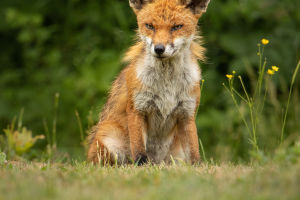The clownfish is a tropical marine fish. They are very popular in aquariums and reefs, loved for their bright colors and playful behavior.
Appearance characteristics: Clownfish are small in size, usually about 7-12 cm in length for adults. They have flattened, oval bodies and are brightly colored, usually orange or yellow, with black vertical stripes. Clownfish have large dorsal and caudal fins with wavy edges.
Parent-Child Bonding: Clownfish make coral reefs their home, and they often form a symbiotic relationship with sea anemones. Clownfish are the only fish that can find shelter and food in the anemone's tentacles. They form a symbiotic relationship with the anemone, with the clownfish protecting the anemone from herbivorous fish while the anemone provides shelter and a food source for the clownfish.
Behavior: Clownfish are social fish that usually live in the shallow waters of coral reefs. Clownfish mainly live a bottom-dwelling lifestyle and like to hide in the tentacles of sea anemones or the crevices around them. They are very brave and alert and will keep their distance from other fish and adopt a defensive posture to protect themselves.
Food sources: Clownfish are omnivorous and feed on plankton, small benthic organisms, and algae. They can obtain food from the tentacles of sea anemones, and will actively forage for plankton and algae on coral reefs.
Reproduction: Clownfish are proto-female and usually live in pairs, each pair consisting of a female and a male. When the female dies or leaves, the male turns into a female.
The breeding process of clownfish is very interesting. The male will dig a nest on the coral reef and attract females to enter the nest to lay eggs. The male guards the eggs and hatchlings in the nest, while also cleaning the nest to maintain suitable environmental conditions. After the juveniles hatch, they swim around the nest and are protected by the male until they can live independently.
Relationship to Humans: Clownfish are very popular in aquariums and are one of the favorite ornamental fish for their unique appearance and interesting behavior. However, factors such as human overfishing, aquatic environment pollution, and coral reef destruction have all threatened the number and living environment of clownfish. Therefore, protecting the health of marine ecosystems and coral reefs is critical to the survival of clownfish.
If you are interested in clownfish farming, it is recommended that you fully understand the relevant knowledge and prepare suitable equipment and environment in advance. Here are some additional farming considerations:
1. Selection of aquarium: Choose an aquarium suitable for clownfish breeding, ensure that the volume is sufficient, and have a good filtration system and water circulation equipment. Considering the activity and bottom habitat of clownfish, choose a spacious aquarium with proper water flow and oxygen supply.
2. Gradual acclimatization: Before introducing clownfish into a new aquarium, a gradual acclimatization process should be carried out. This can reduce stress and acclimatization problems by allowing the clownfish to gradually acclimatize to the new environment in terms of temperature and water quality.
3. Regularly check water quality: Regularly check water quality parameters, including temperature, pH, salinity, etc., and keep them within the appropriate range. In addition, cleaning the filter and changing the water regularly are important steps to keep the water clean and stable.
4. Prevents diseases and infections: Clownfish are susceptible to diseases such as bacteria, parasites, and fungi. Therefore, pay attention to observing the behavior and appearance of clownfish, such as appetite, the state of fins, and abnormalities of the body surface. If abnormalities are found, timely measures are taken, such as isolating sick individuals, providing appropriate treatment, and maintaining good water quality.
5. Provide proper shelter and habitat: Clownfish like to hide and roost in structures such as rocks, caves, and coral. Providing proper shelter and habitat in your aquarium will help your clownfish feel safe and comfortable.
6. Pay attention to population density: When raising clownfish, control the appropriate population density to avoid overcrowding that will lead to increased fighting and stress. Make sure each clownfish has enough space and resources.
Most importantly, clownfish farming requires patience and care, as they are very sensitive to environmental changes and the stability of their farming conditions. Regular observation and maintenance, as well as providing proper diet and environmental regulation, will contribute to the health and reproductive success of clownfish. In addition, understanding the behavior and needs of clownfish, and trying to simulate its natural environment as much as possible, can improve the success rate of breeding.


